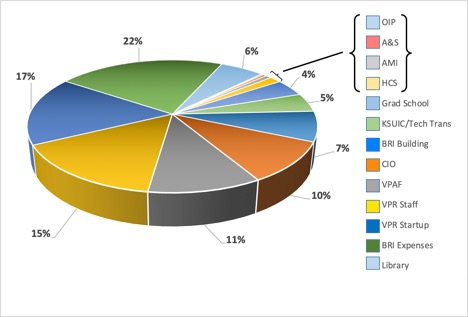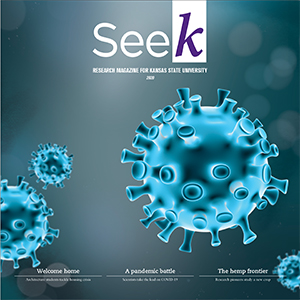From the desk of the VPR: F&A update
The system for determining the F&A cost reimbursement is based on the long-standing principles developed by the Federal Office of Management & Budget (OMB). On a regular basis, representatives from our federal cognizant agency (DHHS) evaluate the actual costs associated with doing research on campus and determine rates that are applied to sponsored research activities carried out at Kansas State. Our negotiated research rate, applicable through fiscal year 2020, is 52%, which is calculated on a modified total direct cost base, resulting in a much lower overall effective recovery of F&A than this rate would otherwise indicate. Information about our different F&A rates is available on our website. Note that the “negotiated rate” is substantially lower than K-State’s “calculated rate” because of certain federal government cost caps and ad hoc discounting that are applied to universities.
The distribution of F&A, known here at K-State as Sponsored Research Overhead (SRO), on various college and university campuses to recover these costs is as varied as the number of institutions involved, since each maintains its own historic perspectives on who bears which costs and how resources are budgeted across the institution. In spring 2015, then K-State President Kirk Schulz and Vice President for Research Karen Burg wrote a K-State Today article articulating some of the specifics about F&A recovered costs at K-State, and VPR Burg followed up with a report to campus about how F&A recovered costs are distributed on campus. She also formed a task force to review the model and to make recommendations about how F&A should be distributed. President Schulz received that report shortly before he departed for Washington State.
The report made recommendations for how K-State should be distributing resources to support the research enterprise and made suggestions about seed funding, core facilities, and large grant program support. We have acted on many of those recommendations as resources permitted, and have held back on others, especially in light of the changes recommended in the Budget Modernization process. Nevertheless, we are modeling how potential changes in F&A distributions may affect the budget process in fiscal year 2020 and beyond.
In the past 18 months, I have presented F&A distribution history and recommendations to the Cabinet, Deans’ Council, the UDPs, campus leadership at a First Tuesday meeting, and most recently at a Faculty Senate meeting. Your questions and feedback at each of these presentations have been very helpful, providing a breadth of perspectives about how local control of resources balanced by university-wide initiatives is very important. Without observing and understanding how the new budget model will affect stakeholders given its many variables, we will not implement changes in F&A distribution without further discourse.
I will note that at each meeting, questions have arisen about how the central F&A pool is spent each year. Overall, since VPR Burg’s report in 2015, the percentages of the distribution of the central F&A recovery pool haven’t changed significantly, but the overall dollar figure has grown, since our total research expenditures and F&A cost recovery have grown. In FY18, our total recovery was more than $20 million, compared to $17 million in FY15. The figure below, although complicated, reveals the relative central F&A distributions to units across campus that support the research enterprise, starting with the Office of International Programs (two o’clock position) and culminating with K-State Libraries. The central F&A recovery pool supports roughly 14% of the total combined general use and restricted use budgets of these groups, leveraging nearly $53 million.

F&A cost recovery is critical to supporting the overall research mission of the university, which is why we are continuously seeking ways to manage our expenses and maintain quality services for faculty, staff, and students involved in research. We are confronted with new research regulatory compliance and training requirements regularly, and we work together with the research associate deans, department heads, center directors, faculty, and staff to identify improvements to our systems while simultaneously seeking economical solutions. Our office is proud of its record to ensure continued support of the swift and effective development and delivery of a record numbers of proposals, awards, and funding levels in the past three years — research at K-State has been growing, involving more PIs than ever before, and supporting record numbers of researchers. Thank you for helping us improve our services.

